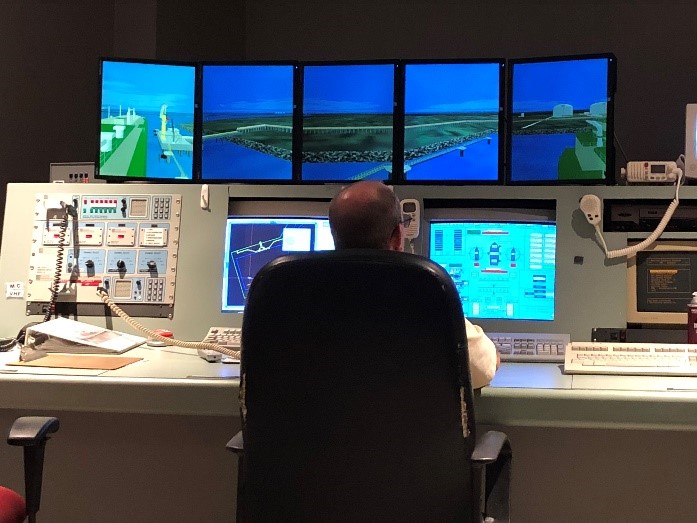In Southeast Texas, it is the duty of the Sabine Pilots to maintain the safety and the environmental integrity of the Sabine-Neches Waterway. The Sabine Pilots have served the shipping industry, the public ports of Port Arthur, Beaumont and Orange counties and the private oil terminals and industrial complexes in the area since 1881.
This month, Sabine Pilots Captains Duane Bennet and Todd Reeder joined the Port Arthur LNG Marine Operations team to run more than a dozen simulations in support of the liquefaction project.
The goal of these simulations was to re-test and affirm project design elements including the turning basin and berthing area required for a Q-max-sized LNG carrier to safely dock at the proposed Port Arthur LNG terminal under a number of different environmental conditions including wind and current. Currently the Q-max is the largest carrier in the world used to transport LNG.
Building a world-class facility
“The Sabine Pilots are critical to the success of being able to transport LNG loads safely through the Sabine-Neches waterway,” said Tom Netzel, marine operations manager, Sempra LNG & Midstream. “The feedback we’ve been able to obtain from the pilots during these simulations will help us continue our efforts in building this world-class facility.”
This feedback included discussion on items ranging from the design of the tug boats and placement of the tug dock, to the number of wind monitors needed and where they should be located, to validating the basin and berth design.
“We appreciate the opportunity to work with Sempra and the Port Arthur LNG team, especially early on in the project to run these simulations,” said Captain Bennett. “We look forward to continuing to grow our relationship as this project is built and becomes operational.”
Marine operations at Port Arthur LNG
From a marine operations perspective, plans for construction of the Port Arthur liquefaction facility will include two jetties, a turning circle, loading arms, mooring equipment and other associated apparatus that will deliver LNG from the vessel to and from the terminal. The Q-max vessel, which in size is a little larger than an aircraft carrier, has a capacity of up to 266,500 cubic meters (m3). That roughly equates to the amount of water in approximately 106 Olympic-sized swimming pools!
US Maritime Resource Center
These LNG carrier bridge simulations were hosted by the United States Maritime Resource Center (USMRC) located in Middletown, Rhode Island.
The simulation room is largely set-up similarly to what you’d see in a movie theatre (or maybe your home) with large television screens that can project video games. The ship simulator is very much like a flight simulator only designed for large ocean-going vessels and is customized for each customer’s project. In this case, the USMRC staff used proposed PALNG blueprints to build an exact terminal replica that can be used for several different, real-time scenarios for the pilots to navigate.
USMRC is an independent, nonprofit marine operations and maritime risk research center and education institute focused on navigation and operational safety, maritime risk mitigation and human capital development.


Comments are closed.